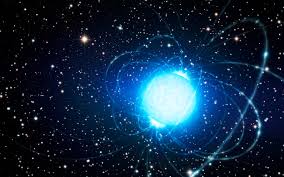Magnetars:

Researchers have found observational evidence that magnetar flares can produce heavy elements like gold through a process known as r-process nucleosynthesis. Until now, gold was believed to form predominantly in neutron star mergers.
- Magnetars are a type of neutron star characterised by exceptionally strong magnetic fields, estimated to be a thousand times stronger than typical neutron stars. Occasionally, they emit intense bursts of energy in the form of flares.
- The discovery was based on data from a giant flare emitted by a magnetar in 2004, during which unusual gamma-ray emissions were recorded almost a day after the initial flare by NASA’s Compton Gamma Ray Observatory.
- The delayed emission was not consistent with standard flare afterglows. Instead, it displayed signatures of radioactive decay from neutron-rich isotopes, suggesting the presence of r-process nucleosynthesis.
- The r-process or rapid neutron-capture process is a series of nuclear reactions where atomic nuclei rapidly capture neutrons, forming heavy elements like gold, platinum, and uranium. It requires extreme energy environments and neutron-rich matter.
- Researchers estimated that approximately 9 septillion kg of r-process material was ejected at nearly light speed during the flare. This material likely underwent rapid neutron capture, resulting in the synthesis of heavy elements.
- This discovery suggests that magnetars could have contributed to the universe’s heavy element inventory much earlier than neutron star collisions, offering insights into the chemical evolution of galaxies.




